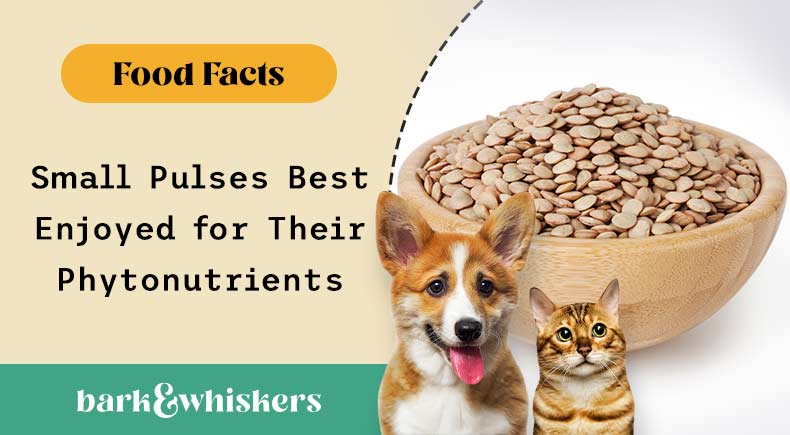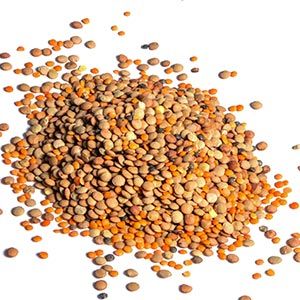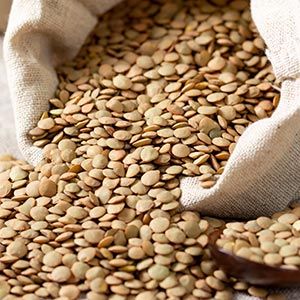Lentils: Small Pulses Best Enjoyed for Their Phytonutrients
These small lens-shaped pulses pack an array of bioactive compounds that may help improve your pet’s health. Find out the best way to serve them to your pet.

STORY AT-A-GLANCE
- Lentils can be beneficial for your pet, but as a treat, topper or add-in to a nutritionally complete, meat-based diet — not as an alternative to animal-based proteins
- One of the ways lentils benefit pets is by providing an array of important bioactive compounds, including antioxidative phenolic acids and flavonoids
- Like many vegetables and plants, lentils contain antinutrients, which can be reduced through proper preparation and cooking methods
- You can sprinkle soaked and cooked lentils on your pet’s meal as an occasional food topper to diversify their diet, or use it as an ingredient in their nutritionally balanced homemade meal or DIY treat. Make sure the bulk of their diet still comes from lean meats and healthy fats
Editor's Note: This article is a reprint. It was originally published January 25, 2023.
Small and lens-shaped with an earthy flavor, lentils (Lens culinaris) are a type of pulse crop belonging to the legume family. They’re one of the oldest known crops in the world and are often used as colorful, filling additions to soups, salads and stews in different cuisines. During World War II, lentils gained popularity as a protein-rich meat alternative in plant-based meals.1,2
But can lentils benefit pets as well? The answer is yes — lentils can be beneficial for your pet, but as a part of their nutritionally balanced, species-appropriate diet — not as an alternative to animal-based proteins. Continue reading to learn why lentils are not an ideal primary protein source for cats and dogs, the role they play in the pet food industry and how to make them a healthy addition to your pet’s diet.
Top Lentil-Producing Countries

Canada leads the world’s lentil production, with a yield of 2.9 million tonnes per year. India comes in second, producing 1.2 million tonnes annually. Australia ranks third, with around 525,800-tonne yearly production.3

One of Lentils’ Strong Suits: They’re Rich in Phytonutrients
One of the ways lentils benefit pets is by providing an array of important bioactive compounds. According to the Journal of Food Science and Technology, “Phenolic acids, flavan-3-ols, proanthocyanidins, anthocyanidins, stilbenes, flavonols, flavones and flavanones are the major polyphenols identified in lentil seeds,”4 contributing to their color as well as biological properties, particularly their antioxidant effect.
An analysis of 11 lentil varieties grown in the U.S. found the predominant phenolic acid in this pulse crop is sinapic acid,5 which was found to exert cardioprotective and anxiolytic-like actions (helping reduce anxiety) in animal models, in addition to exhibiting free radical-scavenging activity.6,7 Sinapic acid also has anti-inflammatory, antimutagenic, neuroprotective and antibacterial effects.8
As for lentils’ flavonoid content, catechins and epicatechins are predominant.9 Both are associated with increased antioxidant activity as well as improved vascular function and gut health in humans.10 Studies show these beneficial properties may also translate to animals.11,12 Anthocyanidins and proanthocyanidins are compounds that may also benefit your pet’s gut health, as they improve gut microbiota.13,14
Gallic Acid: A Potent Antioxidant in Black Lentils
Another notable phenolic found in lentils, particularly the black varieties, is gallic acid. According to a study in the Journal of Functional Foods:15
“Gallic acid is a potent antioxidant, thus even at a lower concentration this compound may make a significant contribution to antioxidant activities especially for Black lentils, whose gallic acid content accounted for 95% of total hydroxybenzoic acids.”
Gallic acid exhibits anti-inflammatory, antioxidant and antimicrobial properties. One study published in Frontiers in Immunology assessed the antioxidant and immune-boosting action of this compound on puppies that were under environmental stress. Results showed that it helped alleviate oxidative stress and inflammation, causing “beneficial shifts on gut microbiota and metabolites” that may lead to improvements in the puppies’ gut health.16
Did You Know?

Different lentil colors have different flavors. Brown lentils have a rich and deep earthy flavor, while green and black varieties are peppery. Red lentils, on the other hand, are the sweetest and nuttiest variety.17
Other Health-Promoting Nutrients Found in Lentils
Lentils contain several vitamins and minerals, including folate.18 A tablespoon serving of lentils provides 22.3 micrograms of folate,19 an essential vitamin that plays a role in healthy DNA production.20,21 Potassium is also found in lentils, which provide 45.4 milligrams (mg) of this mineral per one tablespoon serving.22 Potassium is essential for maintaining intracellular fluid balance as well as proper muscle, nerve and cardiovascular function.23
Lentils are also a good source of iron, especially when eaten with a source of vitamin C to help with its absorption.24 Iron plays a key role in transporting oxygen throughout the body, creating red blood cells and hemoglobin, supporting enzymatic functions and metabolizing energy.25,26 Lentils are high in fiber as well, particularly insoluble fiber (93 to 99.7 mg/g),27,28 which may help promote gut health and normal bowel movement.29
An Important Caveat About Lentils: They Contain Antinutrients
“Because of their high antinutrient content when raw, lentils are not meant to be eaten uncooked. Prepare and cook lentils properly before feeding them to your family, including your pets.”
Like many vegetables and plants, lentils contain antinutrients, which are compounds that can interfere with the absorption of nutrients in humans and animals. One of the major antinutrients in lentils is saponins (25 mg saponins per 100-gram serving30), which can affect the gastrointestinal (GI) lining. In fact, legumes in general are considered the “main source of saponins in the human diet.”31
Lentils are also high in lectins,32 containing 12 mg per 100-gram serving.33 These are sugar-binding proteins that may contribute to GI inflammation and leaky gut. Other antinutrients found in lentils that may contribute to GI issues are tannins, phytic acid and trypsin inhibitors.34 The good news is preparing and cooking lentils properly can help significantly reduce these antinutrients.
Prior to cooking lentils, wash them thoroughly and then soak in water overnight, preferably for at least 16 hours,35 changing the water frequently to get rid of the dissolved antinutrients. Once they’re done soaking, transfer them to a pot and fill with fresh water, just enough to cover all the pieces. Boiling helps deactivate the antinutrients,36 so let them simmer until they’re tender.
More Tips on Serving Lentils to Your Pet
Although lentils’ mild flavor leaves plenty of room for spices and seasoning in human dishes, it’s best to skip these ingredients when preparing these pulses for your pet; serve them plain instead. You can sprinkle soaked and cooked lentils on your pet’s meal as an occasional food topper to diversify their diet, or use it as an ingredient in their nutritionally balanced homemade meal or DIY treat.
You can also offer lentils as training treats, while some pets enjoy puréed lentils spread on a lick mat or stuffed into an interactive toy. Always remember when giving your pet healthy “extras” like fruits and vegetables, all treats, food toppers and add-ins should make up less than 10% of their daily caloric intake.
Are Lentils Sustainable?

Lentils are said to be one of the most sustainable crops, as they help fix atmospheric nitrogen and can store more carbon in the soil than other plants.37 However, testing has shown that some lentil products contain traces of glyphosate,38 a widely used herbicide that’s been linked to cancer in both humans and animals.39
So if you’re thinking of buying lentils, whether for yourself or your pet, make sure to choose sustainably grown, organic or spray-free varieties to avoid potentially dangerous chemicals.
The Role of Lentils in the Pet Food Industry
Because of lentils’ high protein content, processed pet food manufacturers often use them in their formulations as a substitute protein source for meat, along with other protein-rich legumes and pulse crops like chickpeas, green peas and dry beans.
While plant-based proteins may sound healthy for your dogs and cats, the truth is that they’re a poor substitute for animal-based proteins. The reason why pet food manufacturers keep adding plant proteins to pet food is because they’re a much cheaper way to boost the total percentage of protein in their formula than using real meat. “Grain-free” pet foods, in particular, use liberal amounts of legumes.
If you’re thinking about feeding your pet a grain-free diet, then you’re on the right track. But keep in mind that grain-free raw food is significantly different from grain-free kibble. Dry pet food might be free of grains, but it can't be free of carbs, because starch is necessary so that the kibble will stick together during the extrusion process. Here’s an illustration to give you a better idea of their differences:

“Grain-free” kibble is often higher in both whole carbohydrates and purified starches than grain-based dry food. The higher the starch level in any pet food, the less meat-based protein is included. This chronic deficiency of easily digestible meat-derived amino acids can deprive the heart of the nutrients it needs to perform adequately, particularly taurine.
Despite grain-free pet foods being cleared as a risk factor for dilated cardiomyopathy (DCM), legumes and pulses, like lentils, were singled out as potentially problematic ingredients. These ingredients are nontoxic; their consumption does not cause heart disease in people or pets. However, long-term consumption of excessive starch, which dogs and cats have no biological requirement for, from any source, coupled with the lack of adequate meat protein, can create essential amino acid deficiencies and contribute to nutritional cardiomyopathies.
Additionally, a chemical reaction (called the Maillard reaction) between taurine and a carbohydrate during the high heat extrusion process may be contributing to the depletion of taurine in pet food.40 Antinutrients like saponins, trypsin inhibitors, phytates and lectins found in these grain-free pet foods can also interfere with taurine absorption.
This is why I recommend feeding your pet a nutritionally complete meat-based fresh food diet that’s not just grain-free but also low-starch. To avoid nutrient deficiencies, it’s important to make sure the bulk of your pet’s daily caloric intake comes from lean meats and healthy fats, and keep all sources of starch less than 20%.
So to summarize, lentils and other legumes are not toxic to pets, and can even offer health-promoting phytochemicals and nutrients. If you’re planning to give lentils to your pet, make sure to prepare them correctly and offer them in small amounts, as a food topper or an ingredient in their species-appropriate, nutritionally balanced homemade diet. You can also use them as an ingredient in a DIY treat, keeping in mind that all healthy treats should make up less than 10% of your pet’s daily caloric intake.
Sources and References
- 1 Cleveland Clinic, October 4, 2022
- 2,30,33,34 Int J Mol Sci. 2017 Nov; 18(11): 2390
- 3 Tridge, Production of Dried Lentil
- 4 J Food Sci Technol. 2017 Mar; 54(4): 858–870
- 5,9 J. Agric. Food Chem. 2010, 58, 3, 1509–1517
- 6 Biochemical and Biophysical Research Communications. Volume 456, Issue 4, 24 January 2015, Pages 853-859
- 7 Life Sciences. Volume 81, Issue 3, 27 June 2007, Pages 234-240
- 8 Oxid Med Cell Longev. 2016; 2016: 3571614
- 10 UC Davis Department of Nutrition, Catechins and Epicatechins
- 11 J Am Coll Cardiol. 2010 Jun, 55 (25) 2869–2876
- 12 Antioxidants 2020, 9(8), 725
- 13 Animals 2020, 10(3), 531
- 14 Journal of Animal Physiology and Animal Nutrition. May 2022;Volume 106 (Issue 3): Pages 586-613
- 15 Journal of Functional Foods. Volume 18, Part B, October 2015, Pages 1022-1038
- 16 Front Immunol. 2022 Jan 14;12:813890
- 17 The Kitchn, May 2, 2019
- 18 NIH Office of Dietary Supplements, Folate
- 19,22 USDA FoodData Central, Lentils, mature seeds, cooked, boiled, without salt
- 20 Egyptian Journal of Medical Human Genetics volume 21, Article number: 62 (2020)
- 21 British Journal of Nutrition. Volume 101, Issue 2, January 2009, pp. 153 - 164
- 23 Better Crops/Vol. 82 (1998, No. 3), Potassium in Animal Nutrition
- 24 JAMA Netw Open. 2020;3(11):e2023644
- 25 Wag Walking, Iron for Dogs
- 26 Frontiers in Veterinary Science, The Role of Iron in Energy Metabolism in Animals
- 27 Int J Mol Sci. 2017 Nov; 18(11): 2390. (Table 2)
- 28 SFGate, How to Increase Insoluble Fiber Intake
- 29 Animal Wellness Magazine, September 17, 2014
- 31 Pharmaceuticals 2022, 15(10), 1225
- 32 Harvard School of Public Health, Lectins
- 35 LWT - Food Science and Technology. Volume 36, Issue 3, May 2003, Pages 285-293
- 36 J Food Sci Technol. 2017 Mar; 54(4): 909–920
- 37 Global Insights, Lentils: A Low-Carbon, Climate-Smart Crop [Interview]
- 38 Canadian Food Inspection Agency, Safeguarding With Science: Glyphosate Testing in 2015-2016
- 39 Environmental Health Volume 19, Article Number: 18 (2020)
- 40 Journal of Nutrition. 1996 Jan;126(1):195-201











